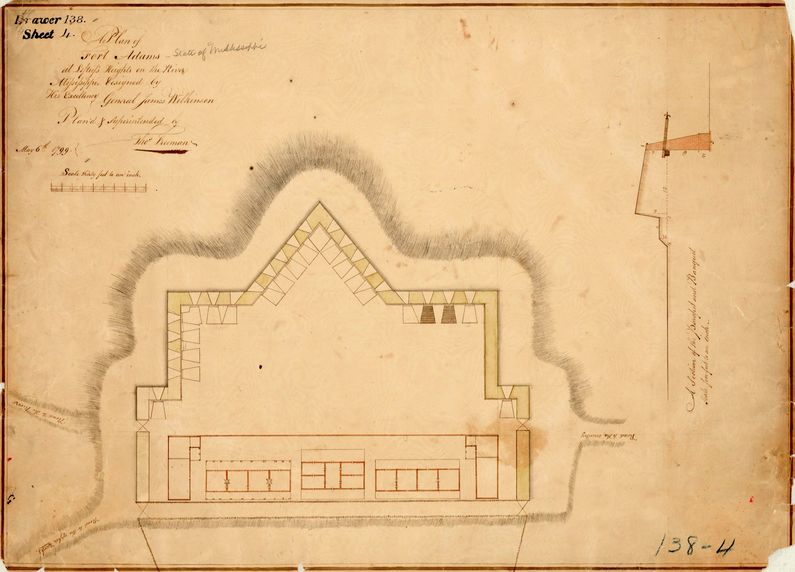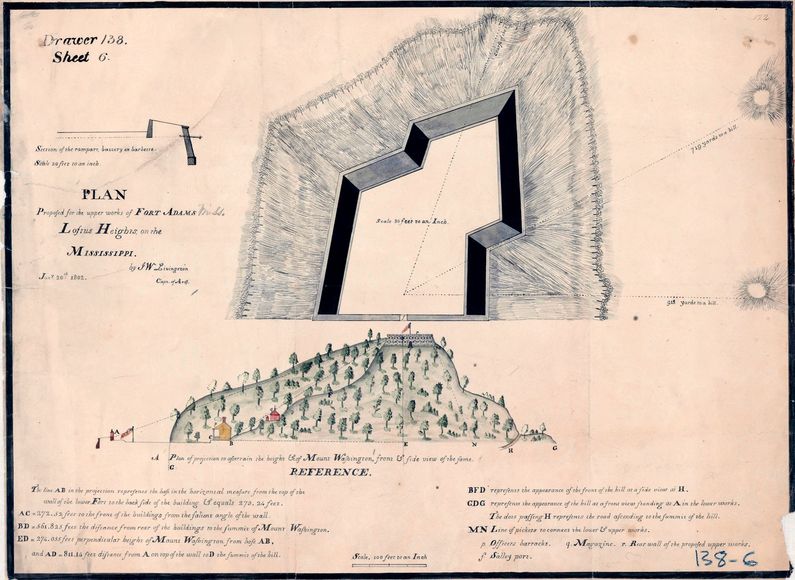Fort Adams (3)
|
Fort Adams (3) (1798-1810) - A U.S. military post first established in 1798 by General James Wilkinson in present-day Wilkinson County, Mississippi. Named after President John Adams. Abandoned in 1810.
Fort Adams (1798-1810)Established on 5 Oct 1798 and built out in 1798 and 1789 as an earthworks fort with barracks, officer's quarters, and a magazine, all on a lower level with river access. In 1802 an upper stone blockhouse was built about 150' higher on top of what was then Mount Washington. The upper blockhouse commanded both the river approaches and the fort below the location is known today as Blockhouse Hill. The post was built after the Spanish abandoned the area and it helped to define and defend the southern border with Spain and to collect tariffs on goods traveling upriver. The nearby Columbian Spring Cantonment was established in 1807 to house troops assigned to the fort. Both the fort and the cantonment were abandoned in 1810. Cuming visited the fort in 1808 and says :(Tour to the West, Chapter 51, in Thwaites, Early Western Travels): "Fort Adams or Wilkinsonburg is a poor little village of a dozen houses, most of them in decay, hemmed in between the heights and the river. The fort from which it derives its first name is situated on a bluff overhanging the river, at the extremity of the ridge of Loftus Heights. It is about one hundred feet above the ordinary level of the Mississippi, which is not more than three hundred feet wide here, so that the fort completely commands it, with several small brass canon (sic) and two small brass howitzers mounted en barbette. The fort which is faced with brick has only a level superfices (sic) large enough for one bastion, with a small barrack inside, the whole of which is commanded by a block-house a hundred and fifty feet higher, on the sharp peak of a very steep hill, which in time of war might serve as a lookout, as well as a post, as it commands a most extensive view over the surrounding wilderness of the forest, as well as the meanders of the river for several miles." A path descended from the blockhouse along "a very narrow ridge" to the town of Wilkinsonburg, later called Fort Adams. Midway down this path was a military cemetery, which included the graves of officers and privates. Officer plots were distinctive because they had headstones listing the name, rank and time of death of the deceased. Also buried in the cemetery were "two or three men" who had been killed in duels Cuming observed from the peak and spotted "two gunboats moored a little above the fort,” while there were also a dozen or more transport boats capable of carrying 30 men and cargo. Columbian Springs Cantonment (1807-1810}During Cuming's visit in August 1809, one company of men was stationed at Fort Adams and five companies were encamped at the separate Columbian Springs Cantonment area. The cantonment area was established in 1807 as quarters for the troops who were not necessary to the operation of the fort, it was abandoned in 1810 as the number of troops declined and the fort closed. Traveling from Fort Adams southward "on a good road,” Cuming encountered the most broken and hilly country he had seen so far. This road west to Pinckneyville, maintained by the soldiers, followed "high and steep precipices." Four miles from Fort Adams, a turn to the right led to the Columbian Springs Cantonment area a mile away on a high hill. Arriving at the cantonment area, Cuming's was "much surprised” with the cantonment area, “differing from any I had ever before seen." Twenty-four huts "faced a wide-open space cleared for a parade, in which is held the market. In the rear of these, with a narrow street between" were 10 "snug and well furnished cottages" where the officers lived, some bachelors and some married men with families. He noted that the "whole camp is constructed with cane (the large reed) in such a manner to render every dwelling perfectly tight and warm." Each cottage was floored "with plank, and the officers' quarters are glazed, and each a little garden." The camp had "an air of neatness" and "cleanliness," where everyone he met was well behaved and mannered. The unusual luxury of the cantonment area did not go unnoticed by the cantonment commander's superiors. The cantonment commander, Colonel Thomas H. Cushing, was given a general court-martial at Baton-Rouge on charges brought by Brigadier General Wade Hampton. Central to the charges was that Colonel Cushing had built "huge and massy buildings in utter disregard and violation" of General Orders to build them on a plan most "slight and cheap." After a year-long court-martial, Colonel Cushing was acquitted of all but some minor specifications and suffered only a written reprimand in general orders. He was promoted to the rank of brigadier general on 2 Jul 1812. The fort and the cantonment area were abandoned circa 1810 as the number of troops declined and the fort closed. Current StatusOn private property in Wilkinson County, Mississippi. The lower fort site is under cultivation. The upper site on Blockhouse Hill has some rock ruins. A marker for the site is located in Woodville at the Library.
Sources:
Links: Visited: 4 Nov 2020
| |||||||||

